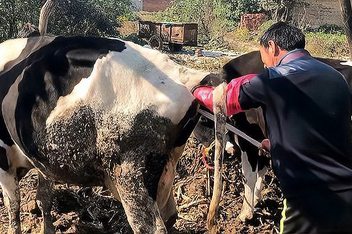If a cow has empty arms, it should be treated according to different situations. There are two reasons for a cow's empty pregnancy: congenital and acquired. Congenital infertility is generally caused by abnormal development of the reproductive organs in dairy cows, such as improper cervical position, vaginal stenosis, infantile diseases, female calves with opposite sex twins, and intersex deformities. Congenital infertility is rare and can be resolved by eliminating carriers of recessive genes in breeding work. Of course, when diagnosing these diseases, the use of B-ultrasound pregnancy testing equipment by Boxiang cattle played a significant role. The main cause of acquired infertility is due to nutritional deficiencies, feeding management, and reproductive organ diseases. Due to the closure of mountains for afforestation and the adoption of grazing bans in various regions, there are no grazing sites left, and cattle can only be raised in captivity, which increases the difficulty of feeding and management. This is also one of the main reasons for the emergence of empty cows. The feeding and management of empty cows mainly revolves around improving the mating and conception rates, fully utilizing roughage, and reducing feeding costs.

Breeding cows should have a medium to high fat condition before mating. When using Boxiang cattle, B-ultrasound pregnancy monitoring devices should be used to prevent excessive obesity and thinness. In daily feeding and management work, cows should have balanced nutrition. If too much concentrate is fed and there is insufficient exercise, it is easy for the herd to become overweight. When cows are observed by B-ultrasound, many follicles do not develop, resulting in non estrus. This is the most common occurrence in the feeding and management of meat cows. Attention must be paid. Of course, in situations where there is a lack of feed and cows are thin and weak, malnutrition may also cause cows to not be in heat and affect reproduction. Practice has proven that if cows are given sufficient balanced diets and well managed during the previous lactation period, the conception rate of cows can be improved. Strengthening the feeding of thin and weak cows 2 months before mating and supplementing them with appropriate concentrate can also improve the conception rate.
tags: B-ultrasound


